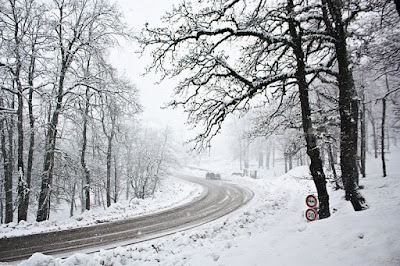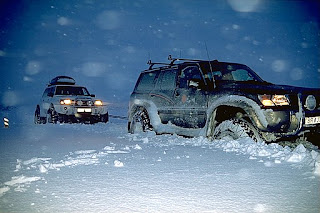Winter Driving
 |
| Tabarka Snow Forest Road by Rotalimus, CC BY-SA 4.0 |
Maneuvering
Slower is better. If the road is very bad, go to an empty parking lot or side street where you won’t hit anything, bring the car up to a safe (and legal) speed, and hit the brakes to see how far you slide. If the car slides, the Automatic Braking System may kick in. This is very useful, especially if the car happens to be sliding straight forward. If the car is sliding sideways, I have found gently pressing the gas to get the tires slowly rolling provides better traction in some conditions. But, brakes are the best basic way to stop the skid, so that’s the best way to go in general.
With rear-wheel drives especially, the nose follows the tail for a skid. Turning slightly in the direction the tail is going can help keep the vehicle safe.
Everything slides. Please be careful and leave plenty of space.
Other drivers
It is best to assume that all the other drivers are crazy southerners who have never seen snow. Stay away from them. In good weather, a large vehicle going about 50 miles an hour on clear roads can take 15 to 30 seconds or more to make a complete stop, once the driver hits the brakes. A fully loaded tractor trailer can take half a mile or more to stop, in good conditions. Stay far away from them.
 |
| Studless Tire 2, by Lombroso, Public domain |
Tires
The more tread, the better for winter driving. To test your tread depth, take a U.S. penny, and stick it into the groves of your tire, with Lincoln’s head upside down. If the hair on the top of Lincoln’s head is visible from eye level with the top of the tire, the tread is low. If his entire head is visible, the tread is at or under 2/32 of an inch, and needs to be replaced. Auto parts stores sell tire tread depth gauges, for those who want a more precise measurement. Check a couple spots, because tires don’t always wear evenly. If the tire mesh is visible, the car is majorly hazardous to drive, and the tires need to be replaced immediately or sooner. Also check for cracks or wear along the sidewalls.
Sand bags
At least one for each back wheel. These are available at most hardware stores, and come in 40 to 60lb bags. (Most stores will load them into your car for you if you ask). Sand bags massively improve the handling on a rear wheel drive, and are nice to have on a front wheel drive. The weight improves traction.
 |
| Stuck in snow by Andreas Tille, CC BY-SA 4.0 |
When the car gets stuck.
Sand or cat litter under the drive wheels can help. Shovel away the excess snow, then put sand as far under the drive tires as possible. Rock the vehicle back and forth. If other adults are present, having someone push the car from behind may help. Ask your passengers to bounce up and down together as you rock it back and forth. Once the car starts to pull free, keep driving slow and steady. Do not stop. Do not stop until the car is safely on the road, or up the closest hill.
Any solution that involves boiling water should be vetoed immediately.
Putting boiling water on an icy or cold windshield will cause it to shatter. It’s designed to withstand impacts, not temperature shocks. It’s not cookware.
While boiling water can melt the snow under your tires, it can also freeze into ice. If the ground is frozen, it’s going to be hard for the water to seep away. So, boiling water leads to ice puddles. If there is a significant amount of snow, a shovel will help more than melting anything.
Please comment with your own best advice or stories from winter driving!
Comments
Post a Comment